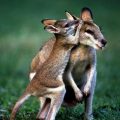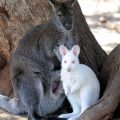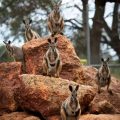As a marsupial or pouched animal, wallaby belongs to the family of the kangaroos. There are actually about 30 different wallaby species called macropod belonging to the scientific family of Macropodidae. The word ‘macropodidae actually means ‘big feet’, because like kangaroos, wallabies have big back legs and that helps them hop, and shorter front legs that work like arms and hands. Like kangaroos, wallabies are widely distributed throughout Australia, New Zealand and their neighboring islands. However, wallabies are significantly smaller than kangaroos. A small number of wallabies can also be found in the UK, as more than 100 wallabies living in the Isle of Man due to zoo escapes.
Wallaby species vary in size; from small to medium. The largest specie can go up to 6 feet (1.8 meters) in height (from head to tail) and weigh around 2 to 24 kilograms (4 to 53 lbs.).
Like kangaroos, wallabies use their powerful hind legs to hopping around at high speed or jump for a few feet. They use their tails for balance and support when sitting. They can also use their back legs to deliver powerful kicks when fighting.
Their Habitat
Unlike kangaroos that lives and dwells in open arid planes, wallabies actually prefer wooded or rugged areas. This means you can usually find them in remote areas. This is because wide open spaces are better for the flat feet of kangaroos. Smaller wallabies can even be seen living in the forests.
There are a lot of different species of wallabies, grouped roughly by their habitat, such as brush wallabies, shrub wallabies and rock wallabies. Hare wallabies got their name for hare-like behavior and size.
Their Diet
As with most marsupials, wallabies are herbivores, which means they feed mainly on grasses and various plants. Their flat teeth and elongated face makes conducive for them to chew different types of vegetation. Some other species, such as the Tammar wallaby, actually prefer areas without any supply of fresh water, and they survive by relying on plant juices. What is more amazing is that, they can even drink salty water.
Life Cycle
Depending on their species, most wallabies are ready to breed when they reach 14 to 19 months old. The female wallaby will give birth to an underdeveloped embryonic young; the newborn joey (wallaby young) will be still blind, have no hair, and as tiny as a bean. When born, it crawls to its mother’s pouch and attach its mouth to one of the teats, which will then swell inside the young wallaby to ensure it will not be detached or dislodged when it’s mom move and hop around.
They leave their mother’s pouch to learn how to hop, but they quickly jump back in as soon as they sense danger. The joey will be ready to leave its mom’s pouch permanently by 8 to 9 months. However, young wallaby will likely stay with its mom for around 24 months.
In the wild, they can live for about 7 to 10 years, and a little longer in captivity, which is about 12 to 15 years.






 Author and long-time animal lover. Sharing knowledge on pet care through experience and the written word.
Author and long-time animal lover. Sharing knowledge on pet care through experience and the written word.